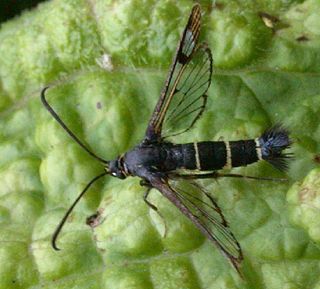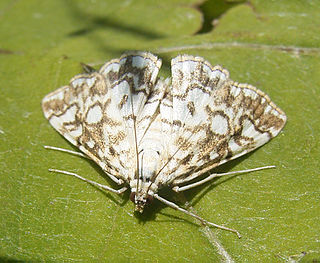| Boeotarcha | |
|---|---|
 | |
| Boeotarcha coemaroalis | |
| Scientific classification | |
| Domain: | Eukaryota |
| Kingdom: | Animalia |
| Phylum: | Arthropoda |
| Class: | Insecta |
| Order: | Lepidoptera |
| Family: | Crambidae |
| Subfamily: | Odontiinae |
| Genus: | Boeotarcha Meyrick, 1884 [1] |
| Boeotarcha | |
|---|---|
 | |
| Boeotarcha coemaroalis | |
| Scientific classification | |
| Domain: | Eukaryota |
| Kingdom: | Animalia |
| Phylum: | Arthropoda |
| Class: | Insecta |
| Order: | Lepidoptera |
| Family: | Crambidae |
| Subfamily: | Odontiinae |
| Genus: | Boeotarcha Meyrick, 1884 [1] |

The Sesiidae or clearwing moths are a diurnal moth family in the order Lepidoptera known for their Batesian mimicry in both appearance and behaviour of various Hymenoptera.
Sir George Francis Hampson, 10th Baronet was an English entomologist.

Pyraustinae is a large subfamily of the lepidopteran family Crambidae, the crambid snout moths. It currently includes about 1,280 species Most of them tropical but some found in temperate regions including both North America and Europe.

Acontiinae is a subfamily of bird dropping moths in the family Noctuidae. There are more than 50 genera and 430 described species in Acontiinae, found worldwide in temperate and tropical climates.

Spilomelinae is a very species-rich subfamily of the lepidopteran family Crambidae, the crambid snout moths. With 4,135 described species in 344 genera worldwide, it is the most speciose group among pyraloids.

Crambinae is a large subfamily of the lepidopteran family Crambidae, the crambid snout moths. It currently includes over 1,800 species worldwide. The larvae are root feeders or stem borers, mostly on grasses. A few species are pests of sod grasses, maize, sugar cane, rice, and other Poaceae. The monophyly of this group is supported by the structure of the tympanal organs and the phallus attached medially to the juxta, as well as genetic analyses.

Hadenini is a tribe of cutworm or dart moths in the family Noctuidae. There are more than 140 genera and 1,000 described species in Hadenini, found worldwide.

Glyphodes is a genus of moths of the family Crambidae described by Achille Guenée in 1854.

Herpetogramma is a genus of moths in the family Crambidae described by Julius Lederer in 1863. It currently comprises 106 species that are found in North America, Eurasia, Australia, New Zealand, Central and South America. Of the few species where host plants are known, the larvae mostly feed on grasses.
Lamprosema is a genus of moths of the family Crambidae described by Jacob Hübner in 1823.

Nacoleia is a genus of moths of the family Crambidae described by Francis Walker in 1859.

Pyrausta is a speciose genus of moths of the family Crambidae. The genus was erected by Franz von Paula Schrank in 1802.
Piletocera is a genus of moths of the family Crambidae. The genus was first described by Julius Lederer in 1863.
The Anerastiini are a tribe of moths of the family Pyralidae.

Acentropinae is a fairly small subfamily of the lepidopteran family Crambidae, the crambid snout moths. Species of this subfamily are exclusively found in wetlands and aquatic habitats.
Pyrausta fieldialis is a moth in the family Crambidae. It is found in Brazil (Parana).
Boeotarcha albotermina is a moth in the family Crambidae. It was described by George Hampson in 1913. It is found in Indonesia, where it has been recorded from Irian Jaya.
Boeotarcha caeruleotincta is a moth in the family Crambidae. It was described by George Hampson in 1918. It is found in Papua New Guinea.
Boeotarcha martinalis is a moth in the family Crambidae. It was described by Francis Walker in 1859. It is found in India.